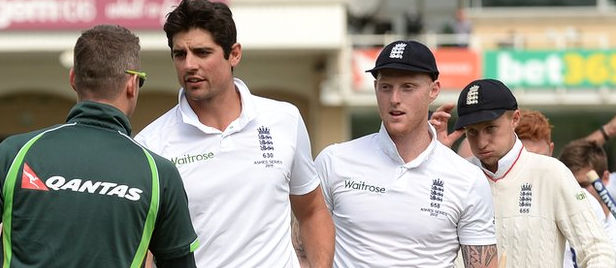England wrapped up a remarkable innings and 78-run victory on Saturday, winning the series 3-1 in the process to regain the famous urn. Here are five things we learnt from the three-day contest at Trent Bridge.
ENGLAND HAVE DEPTH
There were concerns that England wouldn’t be able to cope without the injured James Anderson, but the timing of his absence from the fourth Test and Mark Wood’s absence from the third, couldn’t have been better. Wood’s absence allowed Steven Finn to come in and blow the Aussies away, and Stuart Broad then accepted his responsibilities as the leader of the bowling unit in the fourth Test with career-best figures. Wood came back in and bowled with enthusiastic pace and swing. They’re not risking Anderson for the fifth Test, purely because they don’t need to.
CLARKE LEADS THE EXODUS
After the defeat, Shane Warne said that nine Australian players need to be dropped for the next Test series against Bangladesh. It at first just looks like an angry response to a woeful series, but it does add up. Michael Clarke has of course already retired, then there is six, 30+ potentials in Chris Rogers, Shane Watson, Adam Voges, Shaun Marsh, Brad Haddin and Peter Siddle, while the unselected Fawad Ahmed and the inconsistent Mitchell Johnson are both 33. Jason Gillespie was right – Australia have become ‘Dad’s Army’.
STOKES IS A GENUINE ALL-ROUNDER
The beauty of being an all-rounder is if you fail in one discipline, you always have a chance to make amends with the other. It can be argued that Ben Stokes can make the side as a batsman alone, but the same can’t be said for his bowling. However, despite only scoring 5, he was still a Man of the Match candidate for his career best 6-36 bowling figures, as he showed for the first time that he could swing the ball without dropping his pace. He took two fantastic catches too.
THE SELECTORS LET CLARKE DOWN
The selectors were right to bring in Shaun Marsh to add some batting versatility to their vulnerable lineup, but few were expecting them to replace him for his brother Mitchell. Mitchell came in for Shane Watson for the second Test, and it proved an inspired choice as the 23-year-old took a couple of key wickets and struck some lethal blows with the bat. One disappointing Test followed and he was swiftly dropped. Shaun failed with the bat and Adam Voges scored a fifty at No 6, but dropping the promising talent of Mitchell left Clarke without a fifth bowler to choose from and potential power in the lower-middle order, which England had in the form of Stokes.
ROOT HAS EDGED OUT SMITH
The Test rankings are extremely fickle, and when AB de Villiers gets some Tests under his belt the rankings might change again, but right now it probably best sums up the differences in fortune between Joe Root and Steve Smith. Smith began the series as the best batsman in the world, and his double century at Lord’s backed up that label. Four single-figure scores followed however, raising questions over his exaggerated shuffle across the stumps and his knack for being dismissed to Cook’s well-executed plans, designed especially for him. Root will go into the final Test as the world’s No 1 batsman, testimony to his level of performance throughout the four Tests.







